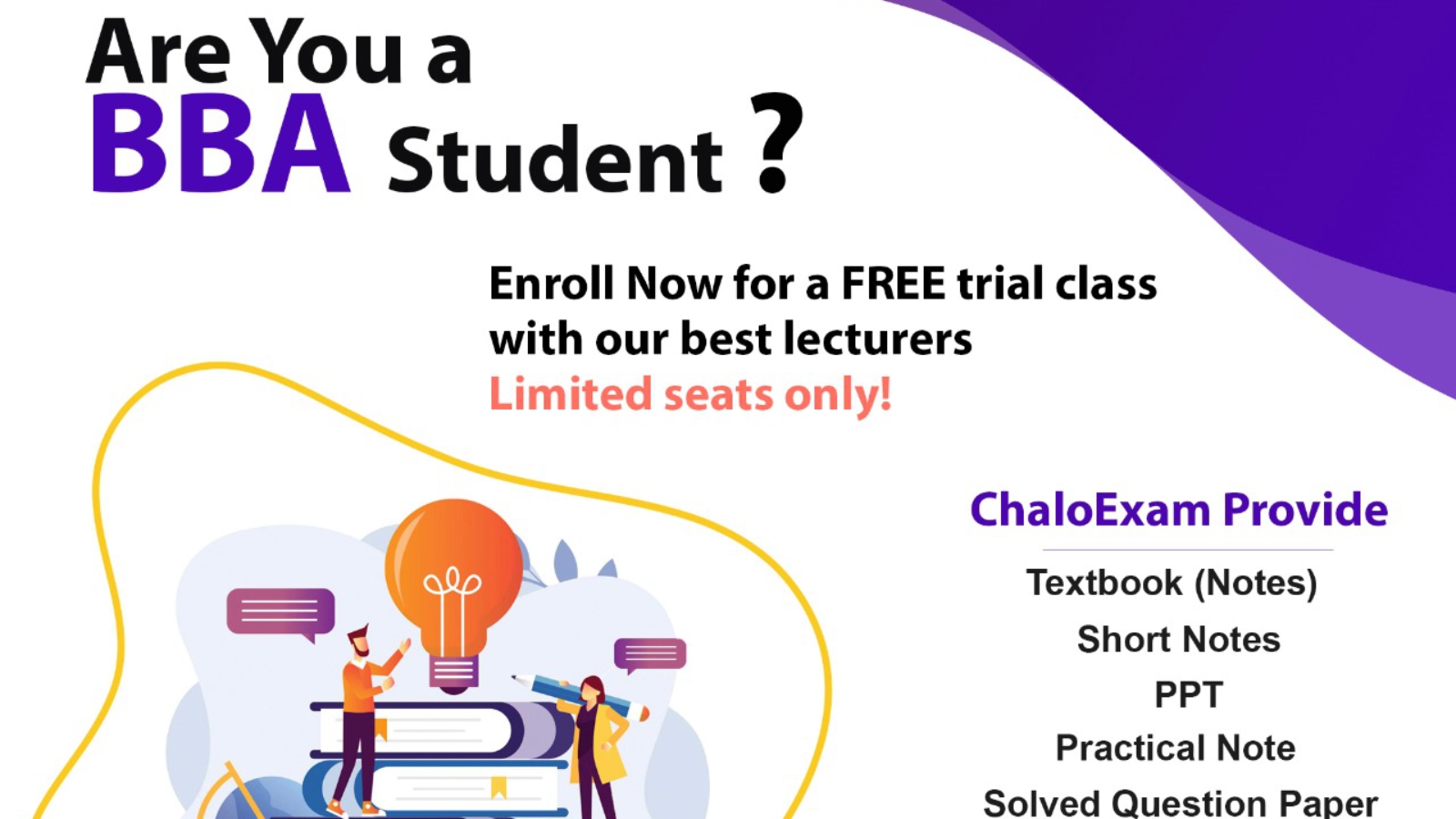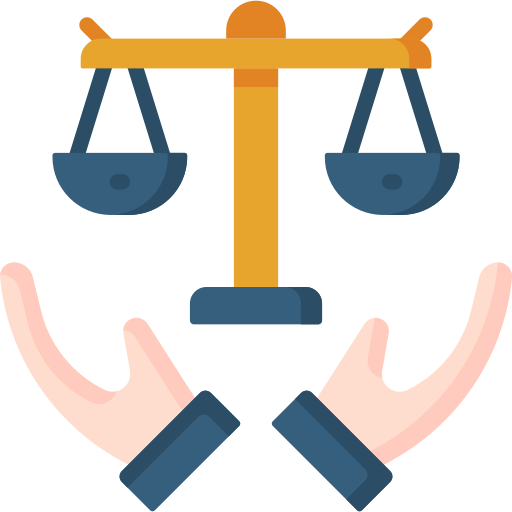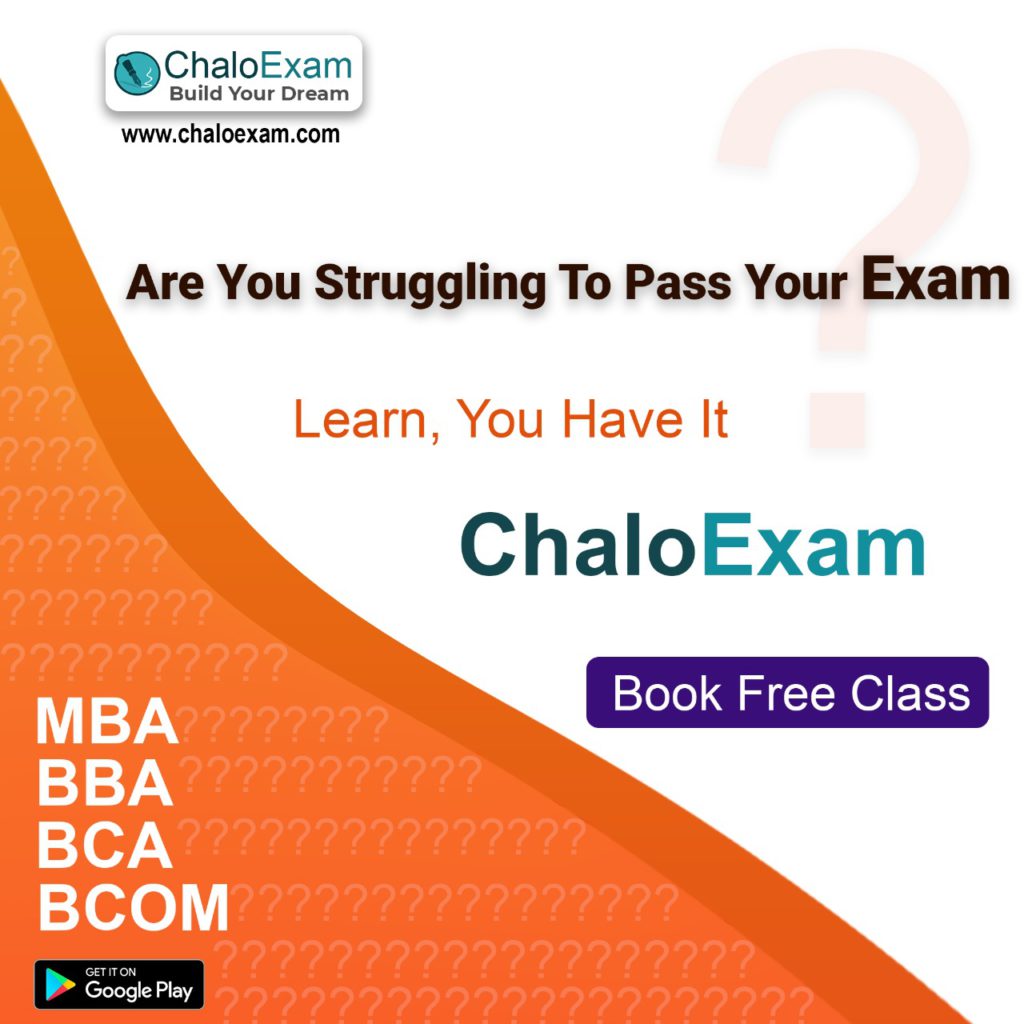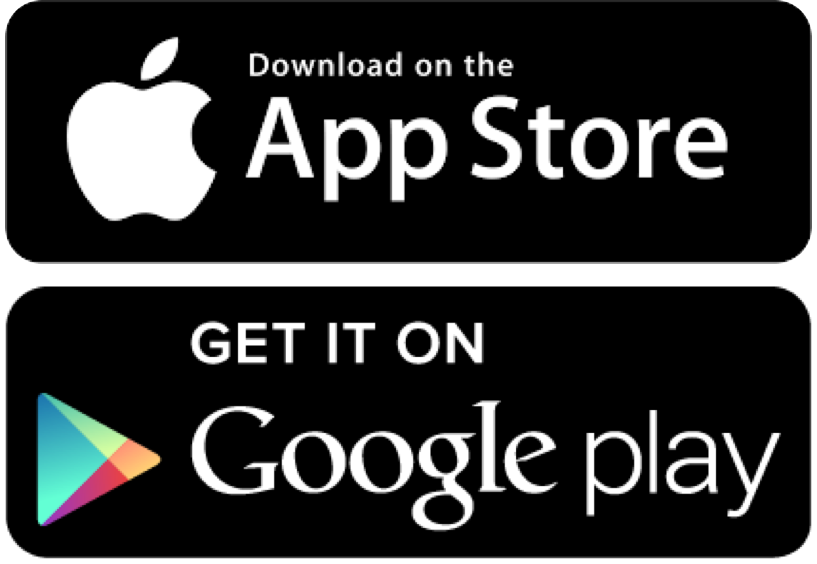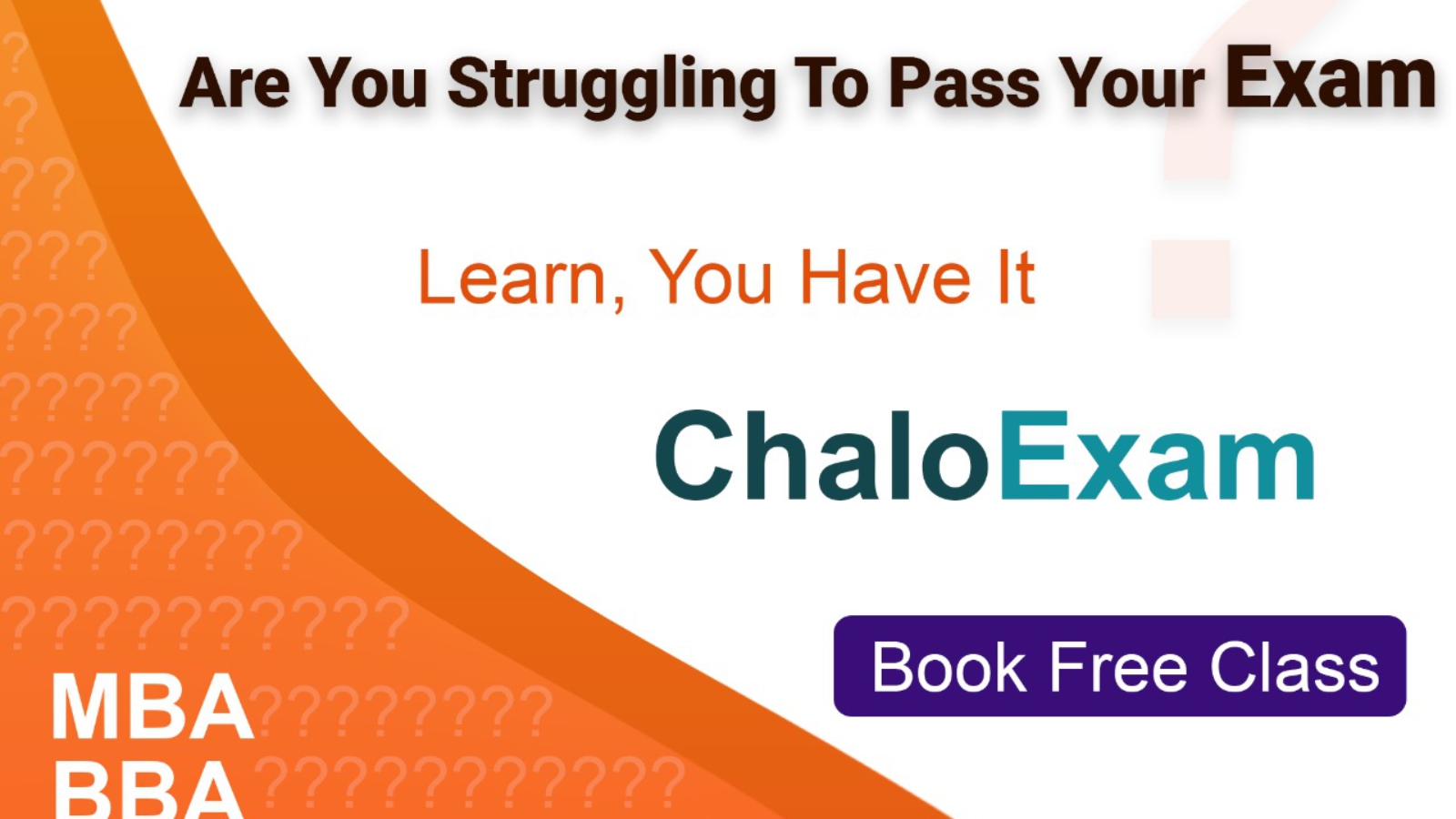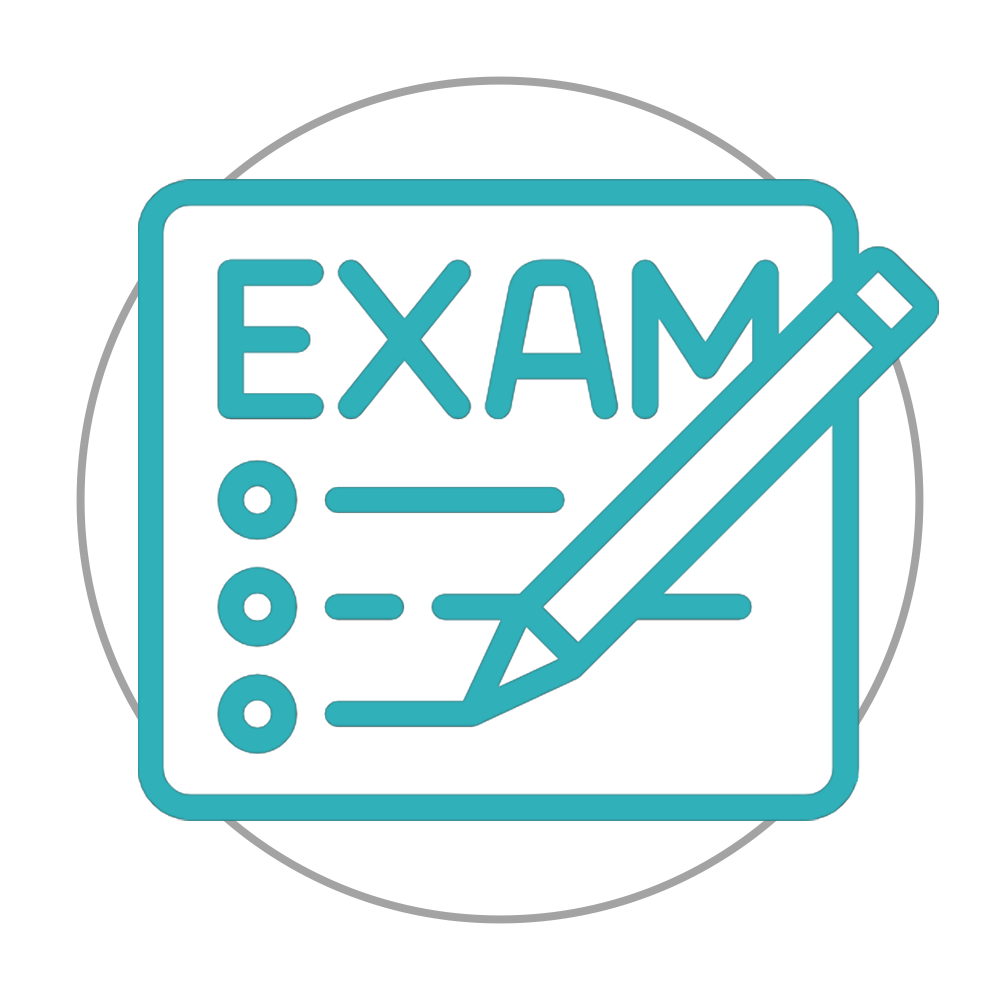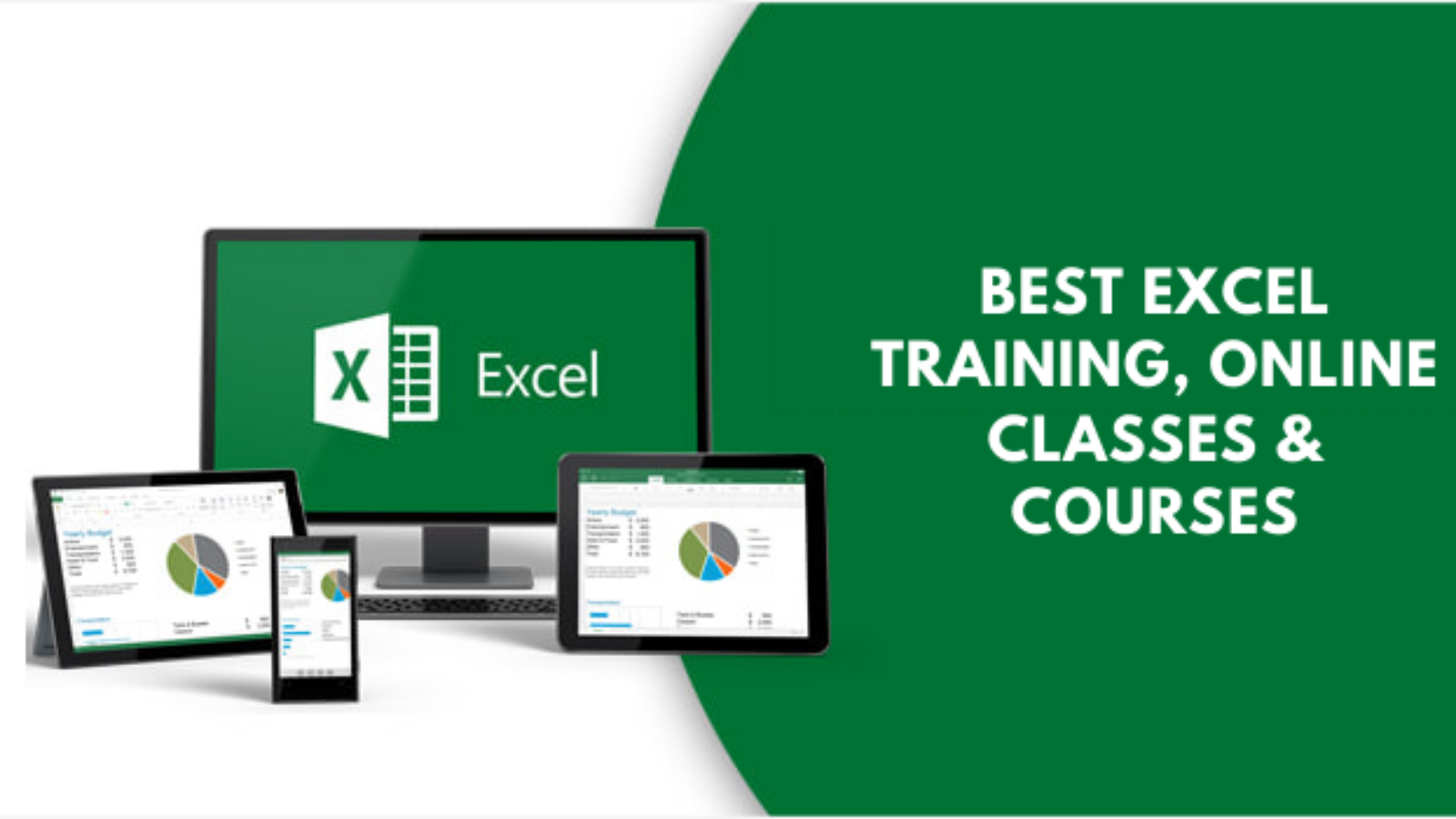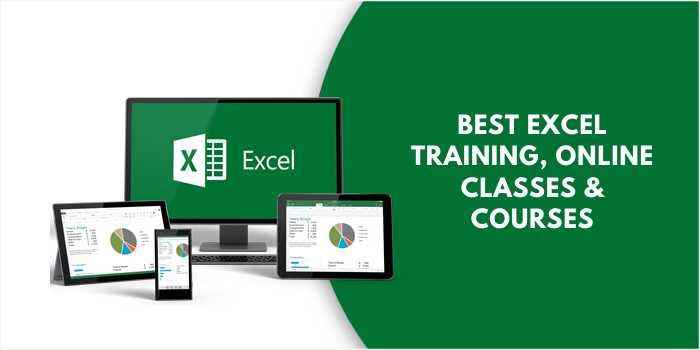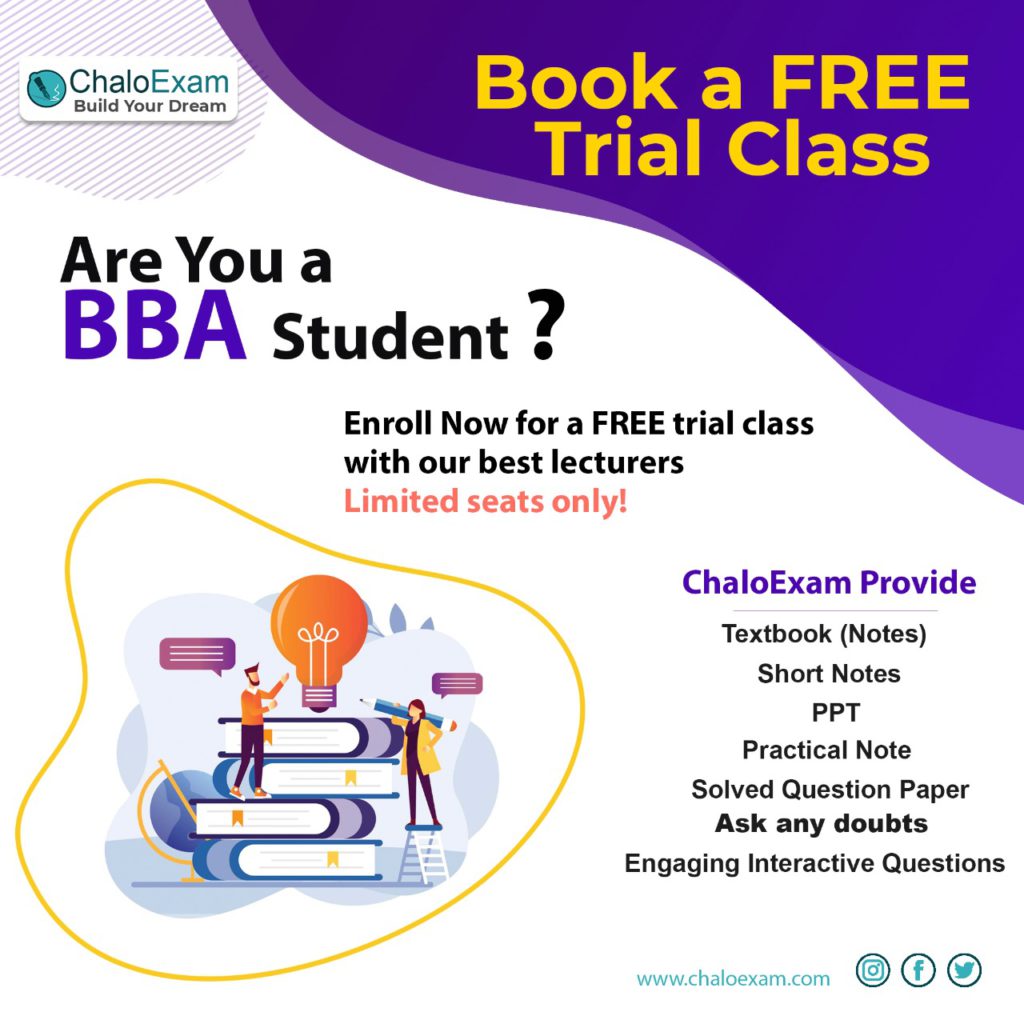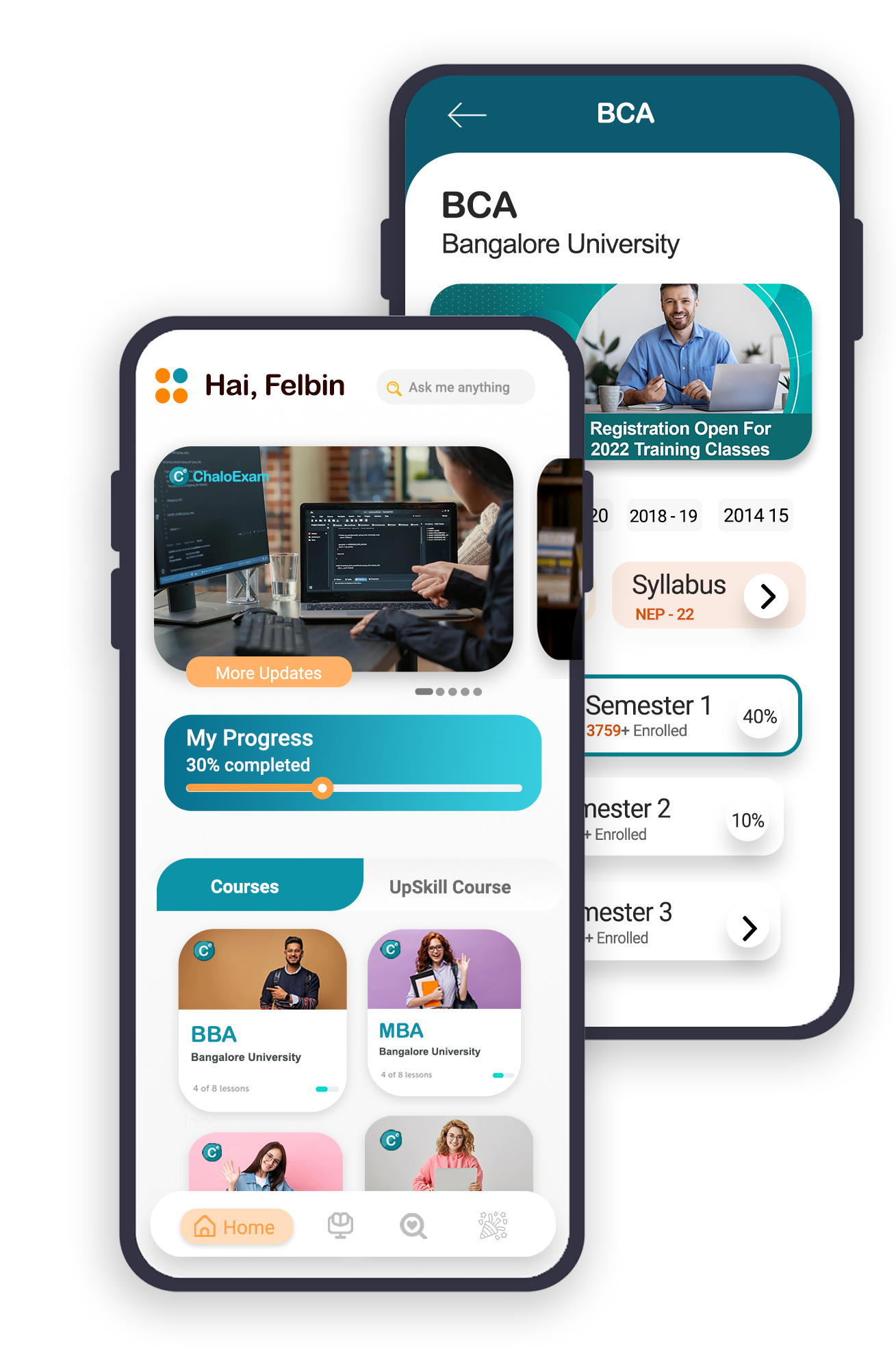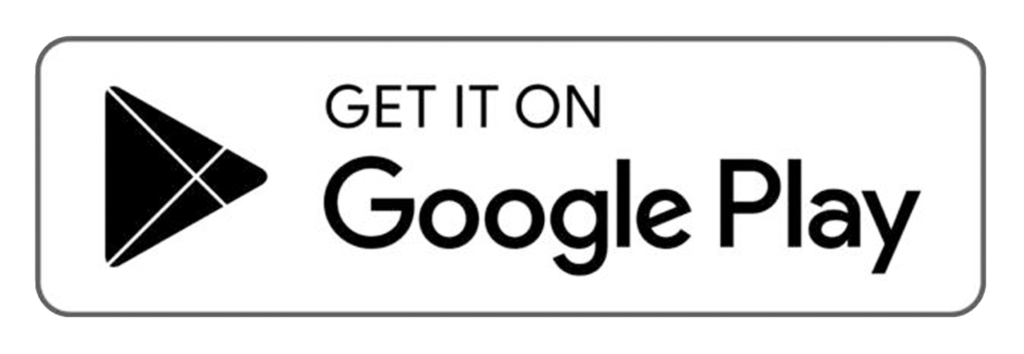Book Free Classes
Bangalore North University 3rd Sem BBA Study Materials
Download free BBA 3rd sem module wise notes, latest solved question papers, previous 5 years question paper till 2021, model question papers, easy notes, exam oriented notes are available on this website chaloexam.com of Bangalore North University
Soft Skills for Business

Soft Skills for Business
Soft Skills for Business
Corporate Accounting

Corporate Accounting
Corporate Accounting
Human Resource Management

Human Resource Management
Human Resource Management
Business Regulations

Business Regulations
Business Regulations
Corporate Environment

Corporate Environment
Corporate Environment
Business Ethics
Bangalore University and Bangalore North University BBA syllabus 2021
Old Syllabus
Syllabus
3.2 SOFT SKILLS FOR BUSINESS
OBJECTIVE:
The objective is to develop both oral and written communication skills relating to organizational and Business issues
Unit 1: ELEMENTS OF COMMUNICATION 14Hrs Meaning, Importance, Objectives & Principles of Communication, , Process, impediments of effective communication, Strategies for effective communication. Types and forms of communication Nonverbal Communication- Body Language, Gestures, Postures, Facial Expressions, Dress codes, The Cross Cultural Dimensions of Business Communication, Listening & Speaking, Techniques of Eliciting Response, Probing Questions, Observation, Business and social etiquette.
Unit 2: PUBLIC SPEAKING 10 Hrs Importance of Public Speaking and Speech Composition - Principles of Effective Speaking& Presentations. Technical speeches & Non-technical presentations. Speech for introduction of a speaker - Speech for vote of thanks -Occasional speech - Theme speech. Moderating programs - Use of Technology
Unit 3: INTERVIEW TECHNIQUES 08 Hrs Importance of Interviews, Art of conducting and giving interviews, Placement interviews - discipline interviews - Appraisal interviews – Exit interviews.
Unit 4: MEETINGS 08Hrs Importance of Meetings -Opening and Closing Meetings - Participating and Conducting Group discussions. Brain Storming, e– Meetings, preparing agenda and minutes of the meeting
Unit 5: BUSINESS COMMUNICATION 16Hrs Business Letters: Inquiries, Circulars, Quotations, Orders, Acknowledgments Executions, Complaints, Claims &Adjustments, Collection letter, Banking correspondence, Agency correspondence, Bad news and persuading letters, Sales letters, Job application letters - Bio-data, Covering Letter, Interview Letters, Letter of Reference. Memos, Minutes, Circulars &Notices.
SKILL DEVELOPMENT
∙ Conduct a mock meeting and draft minutes of the meeting.
∙ Draft a letter of enquiry to purchase a laptop.
∙ Draft your bio-data.
∙ Prepare your Career Plan.
BOOKS FOR REFERENCE
Rai & Rai – Soft Skill for Business, HPH
Santhosh Kumar – Soft Skill for Business, VBH.
C.G.G Krishnamacharyulu&Lalitha :Soft Skills of Personality Development, HPH. 4. Lesikar, R.V. &Flatley, M.E. (2005). Basic Business Communication Skills for
23
Empowering the Internet Generation. Tata McGraw Hill Publishing Company Ltd.,New Delhi. 5. Rai&Rai: Business Communication Himalaya Publishing House
Rajkumar, Basic of Business Communication
Ludlow, R. & Panton, F. (1998). The Essence of Effective Communications. Prentice Hall of India Pvt. Ltd.
M.S. Rao : Soft Skills – Enhancing Employability I.K. International PH.
Rao& Das : Communication Skills, I.K. International PH.
Adair, J. (2003). Effective Communication. Pan McMillan.
Thill, J. V. &Bovee, G. L. (1993). Excellence in Business Communication. McGrawHill, New York. 12. Bowman, J.P. &Branchaw, P.P. (1987). Business Communications: From Process to Product. Dryden Press, Chicago.
Sharma S.P. & Others, Business Communication, VBH.
Banerjee : Soft Skills Business and Professional Communication, I.K. International
24
3.3 CORPORATE ACCOUNTING
OBJECTIVE
The objective of this subject is to enable the students to have a comprehensive understanding about the provisions of the Company‟s Act and Corporate Accounts.
Unit 1: COMPANY FINAL ACCOUNTS 20 Hrs Statutory Provisions regarding preparation of Company Final Accounts – Treatment of Special Items – Managerial Remuneration – Tax deducted at source – Advance payment of Tax – Provision for Tax – Depreciation – Interest on debentures – Dividends – Rules regarding payment of dividends ( Theory only) – Transfer to Reserves – Preparation of Profit and Loss Account and Balance Sheet as per Section 219(1)(b) (IV) and form 23AB. Abridged Profit and Loss Account – Abridged Balance Sheet (Vertical Form).
Unit 2: FINANCIAL STATEMENTS ANALYSIS 10 Hrs Analysis of financial statements – comparative statements, comparative income statement, comparative Balance sheet – common size statements – Common size income statement, common size Balance Sheet – Trend percentages. Reporting to management – Management Decision and Analysis.
Unit 3: VALUATION OF GOODWILL 8Hrs Meaning – Circumstances of Valuation of Goodwill – Factors influencing the value of Goodwill – Methods of Valuation of Goodwill - Average Profit Method – Super Profit Method – Capitalization of Super Profit Method – Annuity Method – Capitalization of Profit Method.
Unit 4: VALUATION OF SHARES 8 Hrs Meaning – Need for Valuation – Factors Affecting Valuation – Methods of Valuation – Asset Backing or Intrinsic Value Method – Yield Method – Earning Capacity Method – Fair Value Method - Rights Issue and Valuation of Rights Issue.
Unit 5: HOLDING COMPANY ACCOUNTS 10 Hrs Introduction – Meaning of Holding Company – Subsidiary Company – Steps – Pre Acquisition Profits – Post Acquisition Profits – Minority Interest – Cost of Control or Capital Reserve – Unrealized Profit – Mutual Indebtedness – Preparation of Consolidated Balance Sheet (As per AS21).
SKILL DEVELOPMENT
Collect and fill the share application form of a limited Company.
Collect a Prospectus of a company and identify the reasons to invest or not to invest in shares. ● List the various functions of underwriters.
Collect annual report of a Company and List out its assets and Liabilities.
Collection of latest final accounts of a company and find out the net Asset value of shares ● List out the conditions to be fulfilled for redemption of Preference shares.
BOOKS FOR REFERENCE
Anil Kumar - Marriappa – Corporate Accounting , HPH.
M.A.Arunachalam & K.S.Raman: Corporate Accounting – II, HPH.
Dr. S.N. Maheswari , Financial Accounting, Jain Book Depot.
V.K. Goyal: Corporate Accounting, PHI.
Soundrarajan A & K. Venkataramana, Corporate Accounting, SHBP.
S. P. Jain and K. L. Narang – Corporate Accounting, Kalyani Publishers.
SP Iyengar, Advanced Accountancy, Sultan Chand and Sons, New Delhi.
R L Gupta, Advanced Accountancy, Sultan Chand and Sons, New Delhi..
25
3.4 HUMAN RESOURCE MANAGEMENT
OBJECTIVE
The objective is to familiarize the students with concepts and principles of Human Resource Management.
Unit 1: HUMAN RESOURCE MANAGEMENT 10 Hrs Introduction – Meaning of HRM – Objectives of HRM – Importance of HRM – Functions and Process of HRM – HR Manager - Duties and Responsibilities – Recent trends in HRM.
Unit 2: HUMAN RESOURCE PLANNING, RECRUITMENT & SELECTION 14 Hrs Meaning – Importance of Human Resource Planning – Benefits of Human Resource Planning. Recruitment – Meaning – Methods of Recruitment. Selection – Meaning – Steps in Selection Process – Problems Involved in Placement.
Unit 3: INDUCTION AND TRAINING 08Hrs Meaning, objective and purpose of Induction: Training- Need for training, benefits of training, identification of training needs and methods of training.
Unit 4: PERFORMANCE APPRAISAL AND COMPENSATION 10Hrs Introduction – Meaning and Definition – Objectives – Methods of Performance Appraisal – Uses and Limitations of Performance Appraisal. Compensation – Meaning of Compensation – Objectives of Compensation.
Unit 5: PROMOTION AND TRANSFERS 08Hrs Meaning and Definition of Promotion - Purpose of promotion, basis of promotion, Meaning of transfer, reasons for transfer, types of transfer, right sizing of work force,need for right sizing.
Unit 6: HUMAN RESOURCE DEVELOPMENT 06Hrs Meaning of HRD, Role of training in HRD, Knowledge Management, Knowledge Resources, Impact of Globalization on Human Resource Management, Problems in relation to Transnational and Multinationals.
SKILL DEVELOPMENT
Prepare a Chart showing the functions of HRM and a brief explanation on the need for each function. ● Prepare an advertisement for recruitment / selection of candidates for any organization of your choice. ● Give observation report of industrial safety practices followed by any organization of your choice ● Develop a format for performance appraisal of an employee.
Choose any MNC and present your observations on training programme.
BOOKS FOR REFERENCE
Aswathappa, Human Resource Management, Tat McGraw Hill.
Madhurimalall, Human Resource Management, HPH.
Reddy &Appanniah, Human Resource Management. HPH.
C.B.Mamoria, Personnel management, HPH.
Edwin Flippo, Personnel management, McGraw Hill.
SubbaRao, Personnel and Human Resources management, HPH.
26
S.Sadri& Others: Geometry of HR, HPH.
Rajkumar : Human Resource Management I.K. Intl 9. Michael Porter, HRM and human Relations, Juta & Co.Ltd. 10. Biswanath Ghosh, Human Resource Development and Management. 11. Rekha & Vibha – Human Resource Management, VBH. 12. K. Venkataramana, Human Resource Management, SHBP. 13. Dr. Alice Mani: Human Resource Management, SBH.
27
3.5 BUSINESS REGULATIONS
OBJECTIVE
The objective is to introduce the students to various regulations affecting business and to familiarize the students with such regulations.
Unit 1: INTRODUCTION TO BUSINESS LAWS 06 Hrs Introduction, Nature of Law, Meaning and Definition of Business Laws, Scope and Sources of Business Law, Fundamental Rights and Directive Principle of State Policies, Principles having economic significance, Overview of Business Laws in India.
Unit 2: CONTRACT LAWS 14 Hrs Indian Contract Act, 1872: Definition of Contract, essentials of a valid contract (all essentials need to be explained in great detail), classification of contracts, breach of contract and remedies for breach of contract. Indian Sale of Goods Act, 1930: Definition of contract of sale, essentials of contract of sale, conditions and warrantees, rights and duties of buyer, rights of an unpaid seller.
Unit 3: INFORMATION LAWS AND RTE 10Hrs Right to Information Act, 2005: Objectives of the RTI Act, Scope, SuoMoto disclosure, Method of seeking information, Eligibility to obtain information, Authorities under the Act,. Right to Education Act: Objectives of the RTE Act – Salient Features.
Unit 4: COMPETITION AND CONSUMER LAWS 12Hrs The Competition Act, 2002: Objectives of Competition Act, the features of Competition Act, components of Competition Act, CCI, CAT, offences and penalties under the Act.
Consumer Protection Act, 1986: Definition of the terms consumer, consumer dispute, defect, deficiency, unfair trade practices and services. Consumer Protection Act, Consumer Redressal Agencies – District Forum, State Commission, National Commission, any two landmark judgments of the Supreme Court.
Unit 5: ECONOMIC AND ENVIRONMENTAL LAWS 14Hrs FEMA 1999: Objects of FEMA, definition of important terms – authorized dealer, currency, foreign currency, foreign exchange, foreign security, Directorate of Enforcement, salient features of the FEMA, offences and penalties,
Environment Protection Act, 1986: Objects of the Act, definitions of important terms – environment, environment pollutant, environment pollution, hazardous substance and occupier, types of pollution, global warming, causes for ozone layer depletion, carbon trade, rules and powers of central government to protect environment in India.
28
SKILL DEVELOPMENT
∙ Prepare a chart showing sources of business law and Indian Constitution Articles having economic significance.
∙ Draft an agreement on behalf of an MNC to purchase raw materials indicating therein terms and conditions and all the essentials of a valid contract.
∙ Draft an application to the Chief Information Officer of any government office seeking information about government spending.
∙ Draft digital signature certificate.
∙ Draft a complaint to District Consumer Forum on the deficiency of service in a reputed corporate hospital for medical negligence.
∙ Collect leading cyber crimes cases and form groups in the class room and conduct group discussion. ∙ Draft a constructive and innovative suggestions note on global warming reduction.
BOOK REFERENCE
K. Aswathappa, Business Laws, Himalaya Publishing House,
K.R. Bulchandni: Business Laws, HPH.
N.D. Kapoor, Business Laws, Sultan chand publications.
S.S. Gulshan, Business Law 3rd Edition, New Age International
S.C. Sharama& Monica : Business Law I.K. International
Tulsian Business Law , Tata McGraw-Hill Education
Dr. K. Venkataraman, SHB Publications.
Kamakshi P & Srikumari P, Business Regulation
Dr. Alice Mani: Business Regulations, SBH.
29
3.6 CORPORATE ENVIRONMENT
OBJECTIVE
The objective is to enable the students to get familiarized with the existing Company Law and Secretarial Procedure.
Unit 1: FORMATION OF COMPANY 14Hrs Promotion of Company – Promotion – Incorporation – Capital Subscription and Certificate of Commencement of Business. Memorandum of Association – Definition – Clauses. Articles of Association – Definition – Contents – Distinction between Memorandum of Association and Articles of Association – Alteration of Memorandum of Association and Articles of Association. Prospectus – Meaning – Contents – Statement in Lieu of Prospectus.
Corporate Social Responsibility initiatives under Companies Act 2013 (Section 135)
Unit 2: CAPITAL OF COMPANY 10 Hrs Share Capital – Meaning of Shares – Kinds of Shares – Merits and Demerits of Shares. Debentures – Meaning – Features – Types – Merits and Demerits, Listing of Shares.
Unit 3: COMPANY MEETINGS 12 Hrs Meaning and Definition – Types of Meeting – Statutory Meeting – Annual General Meeting – Extraordinary General Meeting – Board Meeting and Resolutions.
Unit 4: COMPANY SECRETARY 10Hrs Meaning and Definition – Position – Appointment – Rights – Duties – Liabilities – Qualification and Removal of Company Secretary.
Unit 5: WINDING UP OF COMPANIES 10 Hrs Modes of winding up – commencement of winding up – consequences –official liquidator – powers and duties of liquidator.
SKILL DEVELOPMENT
∙ Drafting of Memorandum of Association, Drafting of Articles of Association. ∙ Drafting Notice of Company Meetings – Annual, Special, Extraordinary and Board meetings. ∙ Drafting Resolutions of various meetings – different types.
∙ Chart showing Company‟s Organization Structure.
∙ Chart showing different types of Companies.
∙ A case study on CSR initiatives of any one company
BOOKS FOR REFERENCE
Maheshwari&Maheshwari, Elements of Corporate Laws, Himalaya Publishers
Dr. P.N. Reddy and H.R. Appanaiah, Essentials of Company Law and Secretarial Practice, Himalaya Publishers. 3. M.C. Shukla&Gulshan, Principles of Company Law, S. Chanda & Co.
Pradeep K. Shinde, Corporate Environment, VBH.
C.L. Bansal, Business & Corporate law, Excel Books.
N.D. Kapoor, Company Law and Secretarial Practice, Sultan Chand & Sons.
S.S Gulshan, Company Law, New Age International.
M.C. Bhandari, Guide to Company Law Procedures, Bhandari Publications.
S.C. Kuchal, Company Law and Secretarial Practice, Chaitanya Publishing.
K. Venkataramana, Service Management, SHBP.
30
3.7 BUSINESS ETHICS
OBJECTIVE
The objective is to provide basic knowledge of business ethics and values and its relevance in modern context.
Unit 1: BUSINESS ETHICS 12 Hrs Introduction – Meaning - Scope – Types of Ethics – Characteristics – Factors influencing Business Ethics – Importance of Business Ethics - Arguments for and against business ethics- Basics of business ethics - Corporate Social Responsibility – Issues of Management – Crisis Management
Unit 2: PERSONAL ETHICS 10 Hrs Introduction – Meaning – Emotional Honesty – Virtue of humility – Promote happiness – karma yoga – proactive – flexibility and purity of mind.
Unit 3: ETHICS IN MANAGEMENT 12 Hrs Introduction – Ethics in HRM – Marketing Ethics – Ethical aspects of Financial Management – Technology Ethics and Professional ethics.
Unit 4: ROLE OF CORPORATE CULTURE IN BUSINESS 10 Hrs Meaning – Functions – Impact of corporate culture – cross cultural issues in ethics
Unit 5: CORPORATE GOVERNANCE 12 Hrs Meaning, scope, composition of BODs, Cadbury Committee, various committees, reports on corporate governance, scope of Corporate Governance, Benefits and Limitations of Corporate Governance with living examples.
SKILL DEVELOPMENT
∙ State the arguments for and against business ethics
∙ Make a list of unethical aspects of finance in any organization
∙ List out ethical problems faced by managers
∙ List out issues involved in Corporate Governance.
∙ List out unethical aspects of Advertising
BOOKS FOR REFERENCE
Murthy CSV: Business Ethics and Corporate Governance, HPH
Bholananth Dutta, S.K. Podder – Corporation Governance, VBH.
Dr. K. Nirmala, Karunakara Readdy : Business Ethics and Corporate Governance, HPH
H.R.Machiraju: Corporate Governance
K. Venkataramana, Corporate Governance, SHBP.
N.M.Khandelwal : Indian Ethos and Values for Managers
S Prabhakaran; Business ethics and Corporate Governance
C.V. Baxi: Corporate Governance
R. R. Gaur, R. Sanghal, G. P. Bagaria; Human Values and Professional ethics
B O B Tricker, Corporate Governance; Principles , Policies and Practices
Michael, Blowfield; Corporate Responsibility
Andrew Crane; Business Ethics
Ghosh; Ethics in Management and Indian ethos.


